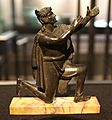Germanic paganism facts for kids
Germanic paganism was an old religion practiced by people in parts of Europe long ago. It was popular in Central and Northern Europe before Christianity became the main religion there. A well-known part of this religion is what we now call Norse paganism. People who followed Germanic paganism believed in many gods. This is called being polytheistic. Some of the most important gods were Odin and Thor. Long before them, a god named Tyr might have been the most important.
How Old Gods Influence Our Days
The ancient Germanic gods still affect our lives today, especially in countries where people speak Germanic languages like English. A clear example is how some of our days of the week got their names.
Originally, the names for the days of the week came from Roman gods in Latin. These were named after the Sun, Moon, Mars, Mercury, Jupiter, Venus, and Saturn.
| Day | Origin |
|---|---|
| Monday | Moon's day |
| Tuesday | Tiw's (Tyr's) day |
| Wednesday | Wóden 's (Odin's) day |
| Thursday | Þunor's (Thor's) day |
| Friday | Frigg's day |
| Sunday | Sun's day |
In Germanic languages, the names for Tuesday through Friday were changed. They were replaced with names of Germanic gods that were similar to the Roman ones. For example, Tuesday is named after Tyr, and Thursday is named after Thor.
In English and Dutch, the name for Saturday was not changed from the Roman god Saturn. However, in German, Saturday is named after the Sabbath. In Scandinavia, it is sometimes called "washing day."
Also, many places in England have names that come from these old gods. For example, Woodway House, Wansdyke, Thundersley, and Frigedene are all named after ancient deities.
Images for kids
-
Emil Doepler's depiction of the Second Merseburg Charm, 1905. In the charm, gods from continental Germanic mythology heal a horse.
-
Map of the Roman Empire and Magna Germania, c. 120 CE
-
The gilded side of the Trundholm Sun Chariot, from the Nordic Bronze Age
-
The Royal Mounds at Gamla Uppsala contain hundreds of burial mounds.
-
A picture of Saint Boniface cutting down Donar's Oak from The Little Lives of the Saints (1904).
-
The Fraubillen cross, a tall stone reshaped into a cross.
-
This silver Thor's hammer was found in Scania. It was given to the Swedish History Museum in 1895.
-
The Gundestrup cauldron, now in the National Museum of Denmark in Copenhagen.
-
A stone slab from The King's Grave in southern Sweden, from the Nordic Bronze Age, around 1400 BC.
-
A drinking scene on an image stone from Gotland, found in the Swedish Museum of National Antiquities in Stockholm.
-
The Franks Casket, shown at the British Museum; the front and lid.
See also
 In Spanish: Paganismo germánico para niños
In Spanish: Paganismo germánico para niños














